Attached files
| file | filename |
|---|---|
| 8-K - 8-K - American Railcar Industries, Inc. | september2017presentation.htm |
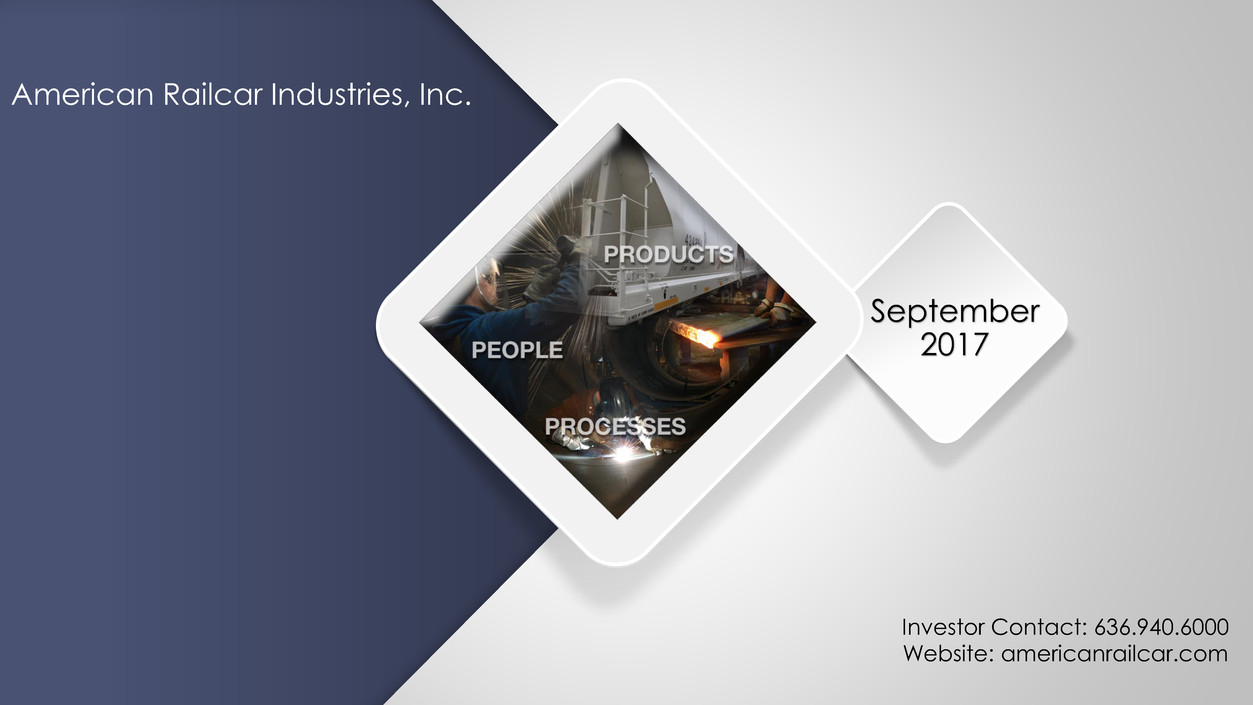
September
2017
Investor Contact: 636.940.6000
Website: americanrailcar.com
American Railcar Industries, Inc.
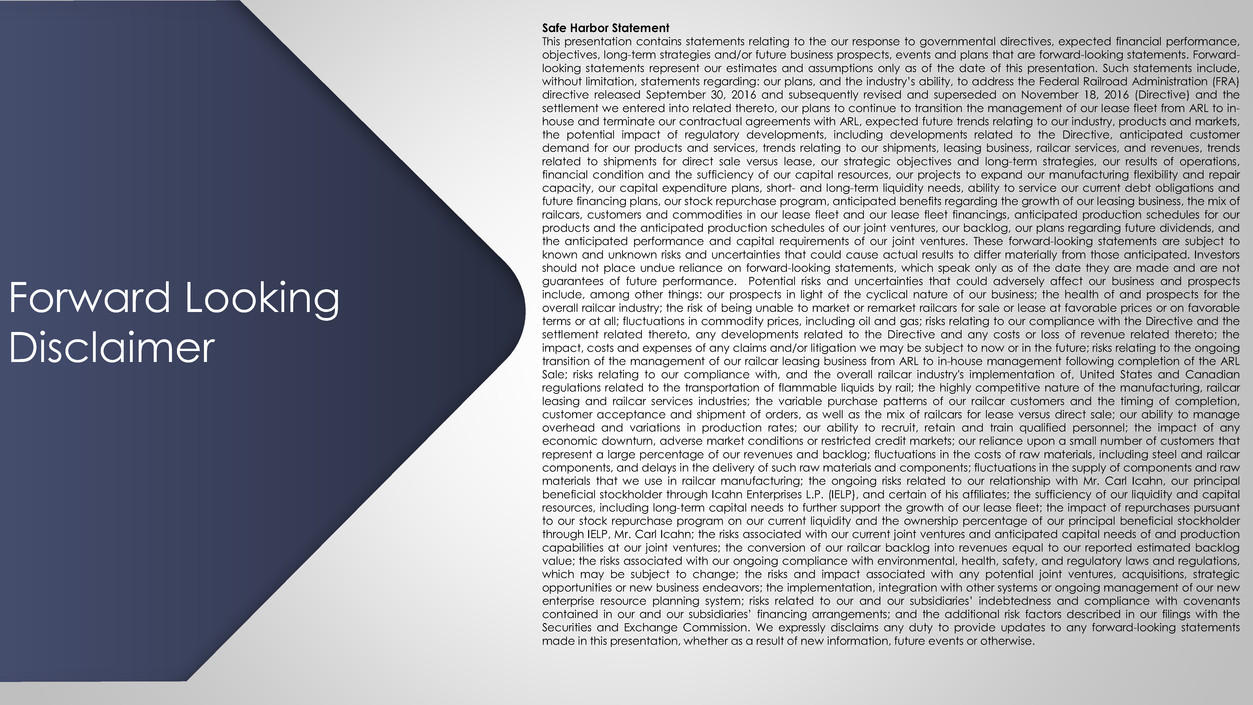
Forward Looking
Disclaimer
Safe Harbor Statement
This presentation contains statements relating to the our response to governmental directives, expected financial performance,
objectives, long-term strategies and/or future business prospects, events and plans that are forward-looking statements. Forward-
looking statements represent our estimates and assumptions only as of the date of this presentation. Such statements include,
without limitation, statements regarding: our plans, and the industry’s ability, to address the Federal Railroad Administration (FRA)
directive released September 30, 2016 and subsequently revised and superseded on November 18, 2016 (Directive) and the
settlement we entered into related thereto, our plans to continue to transition the management of our lease fleet from ARL to in-
house and terminate our contractual agreements with ARL, expected future trends relating to our industry, products and markets,
the potential impact of regulatory developments, including developments related to the Directive, anticipated customer
demand for our products and services, trends relating to our shipments, leasing business, railcar services, and revenues, trends
related to shipments for direct sale versus lease, our strategic objectives and long-term strategies, our results of operations,
financial condition and the sufficiency of our capital resources, our projects to expand our manufacturing flexibility and repair
capacity, our capital expenditure plans, short- and long-term liquidity needs, ability to service our current debt obligations and
future financing plans, our stock repurchase program, anticipated benefits regarding the growth of our leasing business, the mix of
railcars, customers and commodities in our lease fleet and our lease fleet financings, anticipated production schedules for our
products and the anticipated production schedules of our joint ventures, our backlog, our plans regarding future dividends, and
the anticipated performance and capital requirements of our joint ventures. These forward-looking statements are subject to
known and unknown risks and uncertainties that could cause actual results to differ materially from those anticipated. Investors
should not place undue reliance on forward-looking statements, which speak only as of the date they are made and are not
guarantees of future performance. Potential risks and uncertainties that could adversely affect our business and prospects
include, among other things: our prospects in light of the cyclical nature of our business; the health of and prospects for the
overall railcar industry; the risk of being unable to market or remarket railcars for sale or lease at favorable prices or on favorable
terms or at all; fluctuations in commodity prices, including oil and gas; risks relating to our compliance with the Directive and the
settlement related thereto, any developments related to the Directive and any costs or loss of revenue related thereto; the
impact, costs and expenses of any claims and/or litigation we may be subject to now or in the future; risks relating to the ongoing
transition of the management of our railcar leasing business from ARL to in-house management following completion of the ARL
Sale; risks relating to our compliance with, and the overall railcar industry's implementation of, United States and Canadian
regulations related to the transportation of flammable liquids by rail; the highly competitive nature of the manufacturing, railcar
leasing and railcar services industries; the variable purchase patterns of our railcar customers and the timing of completion,
customer acceptance and shipment of orders, as well as the mix of railcars for lease versus direct sale; our ability to manage
overhead and variations in production rates; our ability to recruit, retain and train qualified personnel; the impact of any
economic downturn, adverse market conditions or restricted credit markets; our reliance upon a small number of customers that
represent a large percentage of our revenues and backlog; fluctuations in the costs of raw materials, including steel and railcar
components, and delays in the delivery of such raw materials and components; fluctuations in the supply of components and raw
materials that we use in railcar manufacturing; the ongoing risks related to our relationship with Mr. Carl Icahn, our principal
beneficial stockholder through Icahn Enterprises L.P. (IELP), and certain of his affiliates; the sufficiency of our liquidity and capital
resources, including long-term capital needs to further support the growth of our lease fleet; the impact of repurchases pursuant
to our stock repurchase program on our current liquidity and the ownership percentage of our principal beneficial stockholder
through IELP, Mr. Carl Icahn; the risks associated with our current joint ventures and anticipated capital needs of and production
capabilities at our joint ventures; the conversion of our railcar backlog into revenues equal to our reported estimated backlog
value; the risks associated with our ongoing compliance with environmental, health, safety, and regulatory laws and regulations,
which may be subject to change; the risks and impact associated with any potential joint ventures, acquisitions, strategic
opportunities or new business endeavors; the implementation, integration with other systems or ongoing management of our new
enterprise resource planning system; risks related to our and our subsidiaries’ indebtedness and compliance with covenants
contained in our and our subsidiaries’ financing arrangements; and the additional risk factors described in our filings with the
Securities and Exchange Commission. We expressly disclaims any duty to provide updates to any forward-looking statements
made in this presentation, whether as a result of new information, future events or otherwise.
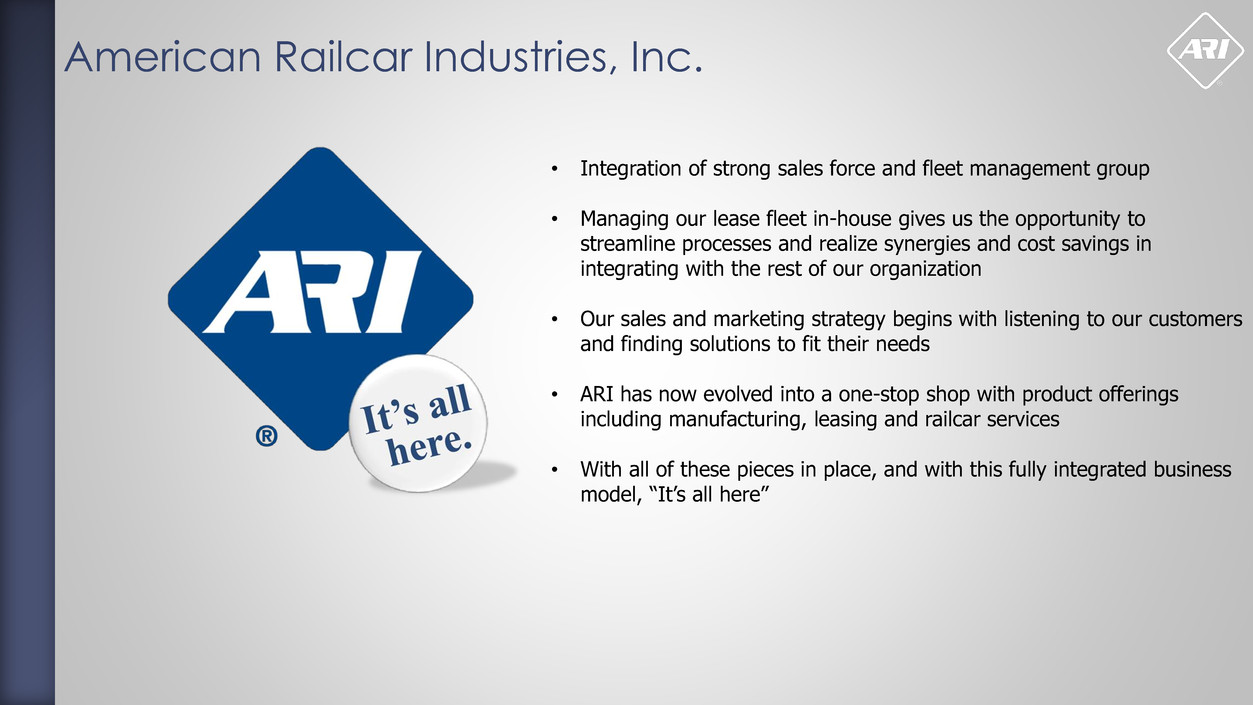
American Railcar Industries, Inc.
• Integration of strong sales force and fleet management group
• Managing our lease fleet in-house gives us the opportunity to
streamline processes and realize synergies and cost savings in
integrating with the rest of our organization
• Our sales and marketing strategy begins with listening to our customers
and finding solutions to fit their needs
• ARI has now evolved into a one-stop shop with product offerings
including manufacturing, leasing and railcar services
• With all of these pieces in place, and with this fully integrated business
model, “It’s all here”
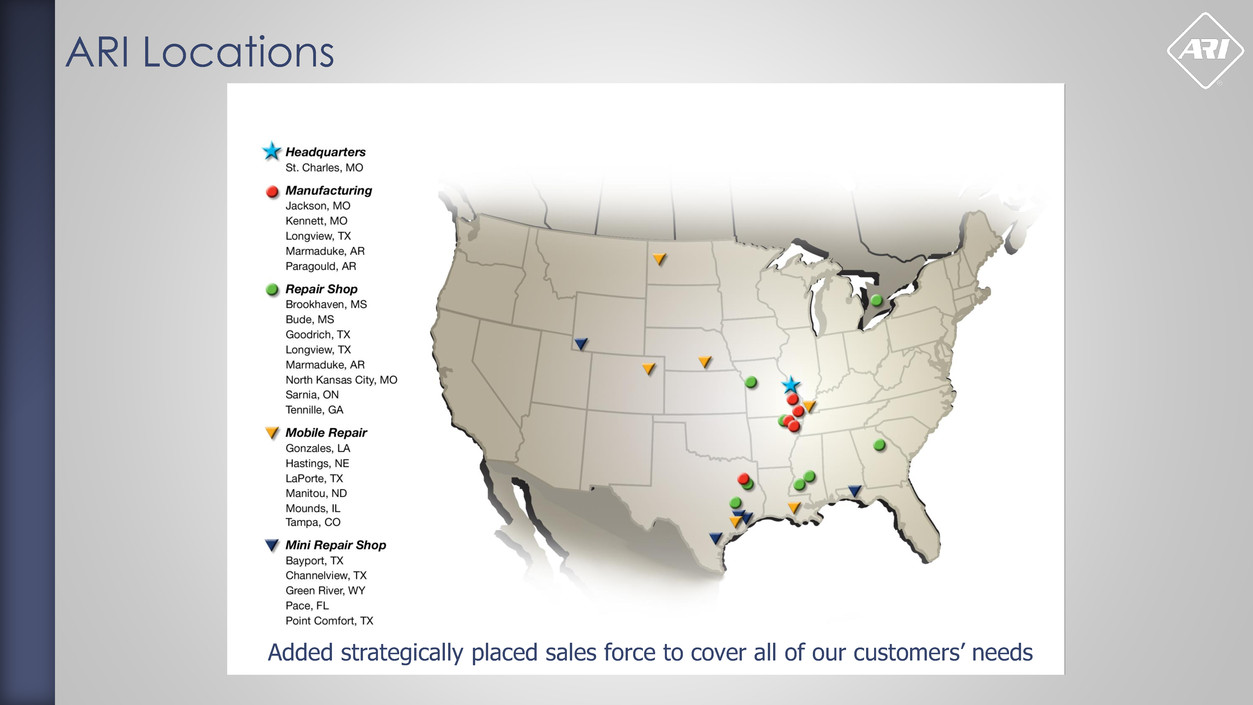
ARI Locations
Added strategically placed sales force to cover all of our customers’ needs

ARI Key Railcar Markets -
Two Largest Product Segments in the Railcar Industry*
TANK RAILCARS
• Product offerings include general service,
pressurized, coiled, lined and insulated
carbon steel or stainless steel railcars that
are capable of transporting:
• Chemicals
• Ethanol
• Food Products
• Natural Gas Liquids
• Crude Oil
HOPPER RAILCARS
• Product offerings include general service
and specialty carbon steel or stainless steel
railcars that are capable of transporting:
• Plastic Pellets
• Food Products
• Grain
• Sand
• Specialty Chemical Products
• Cement
* Based upon backlog as of 6/30/17 per the Railway Supply Institute, Inc ARCI 2017 – 2nd Quarter Reporting Statistics (issued July 2017)
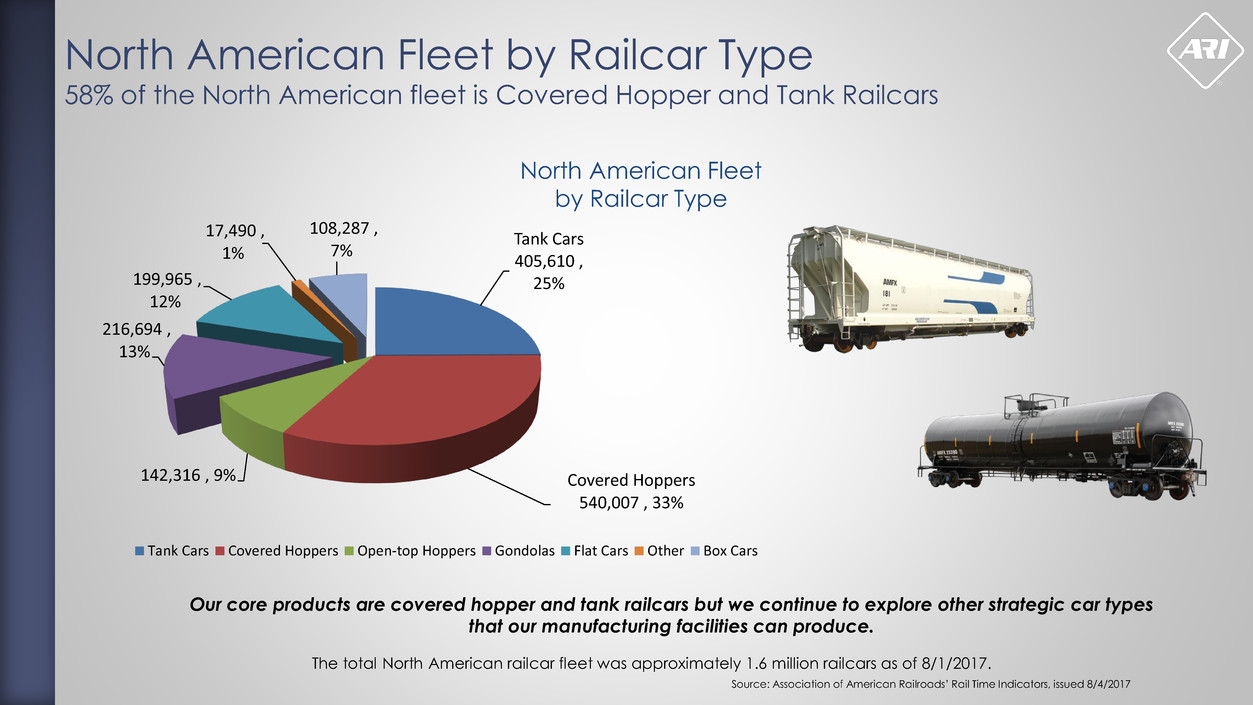
North American Fleet by Railcar Type
58% of the North American fleet is Covered Hopper and Tank Railcars
The total North American railcar fleet was approximately 1.6 million railcars as of 8/1/2017.
Tank Cars
405,610 ,
25%
Covered Hoppers
540,007 , 33%
142,316 , 9%
216,694 ,
13%
199,965 ,
12%
17,490 ,
1%
108,287 ,
7%
Tank Cars Covered Hoppers Open-top Hoppers Gondolas Flat Cars Other Box Cars
North American Fleet
by Railcar Type
Source: Association of American Railroads’ Rail Time Indicators, issued 8/4/2017
Our core products are covered hopper and tank railcars but we continue to explore other strategic car types
that our manufacturing facilities can produce.
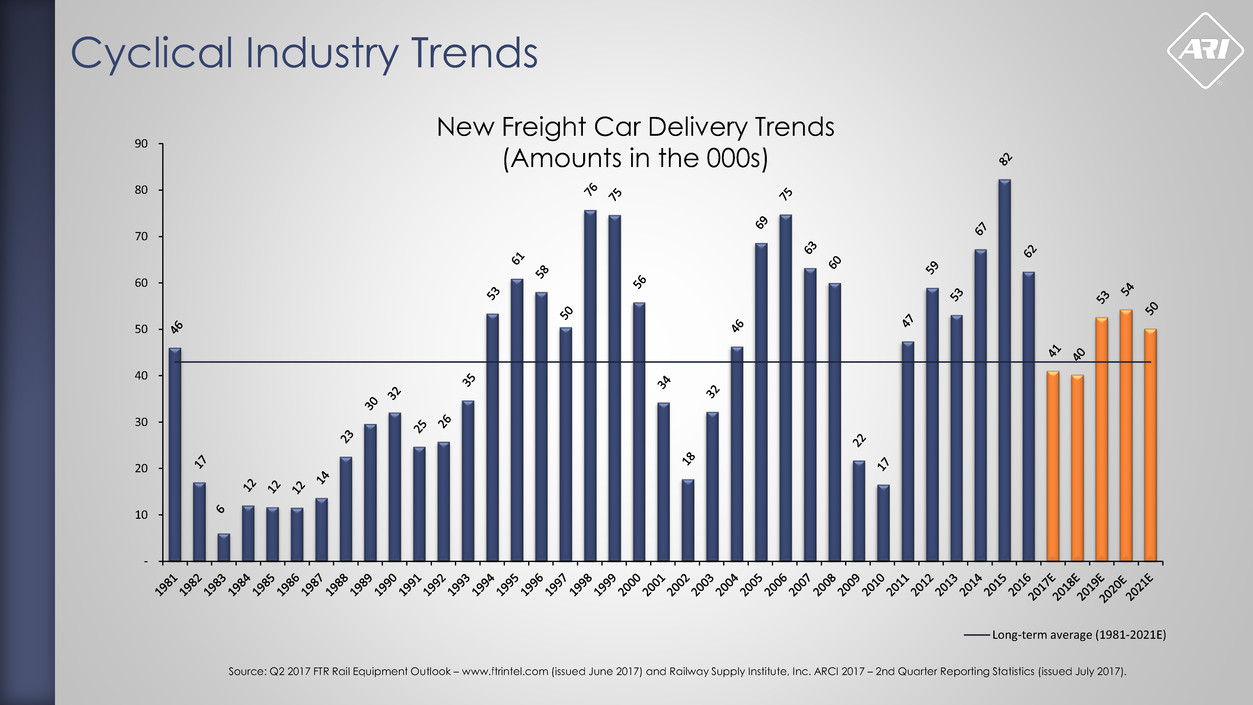
Cyclical Industry Trends
-
10
20
30
40
50
60
70
80
90
Long-term average (1981-2021E)
New Freight Car Delivery Trends
(Amounts in the 000s)
Source: Q2 2017 FTR Rail Equipment Outlook – www.ftrintel.com (issued June 2017) and Railway Supply Institute, Inc. ARCI 2017 – 2nd Quarter Reporting Statistics (issued July 2017).
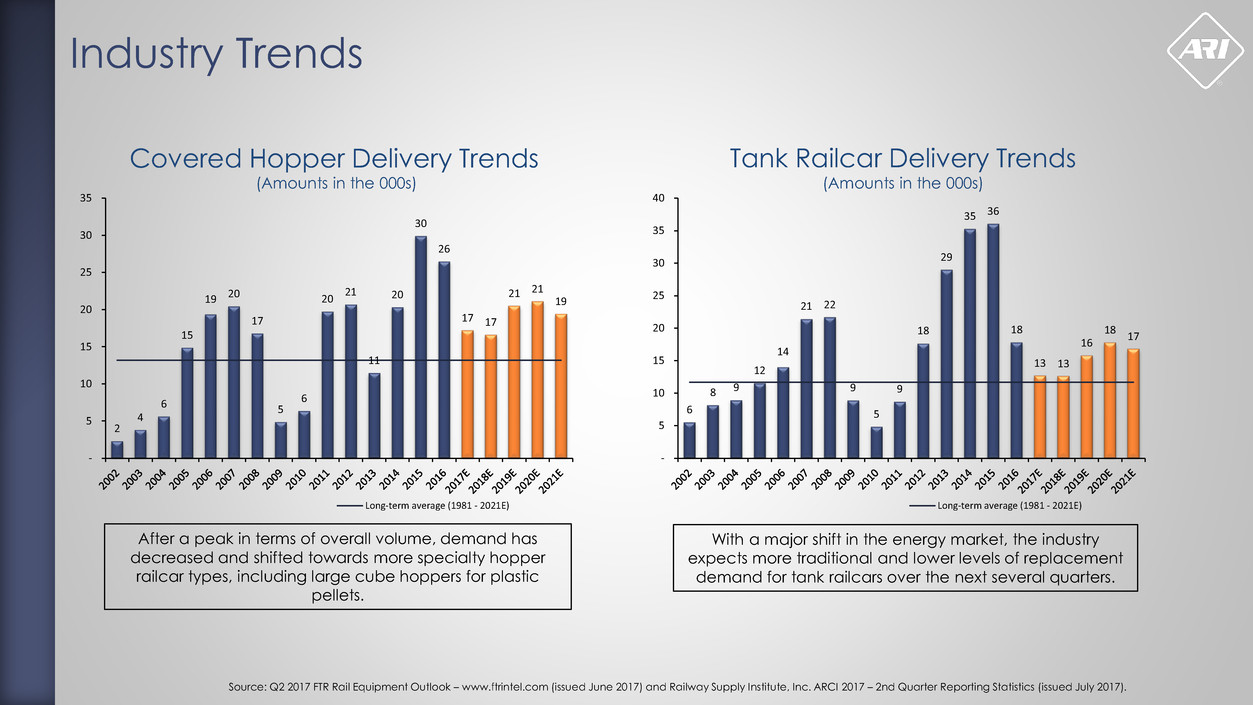
2
4
6
15
19 20
17
5
6
20
21
11
20
30
26
17 17
21 21
19
-
5
10
15
20
25
30
35
Long-term average (1981 - 2021E)
Industry Trends
Covered Hopper Delivery Trends
(Amounts in the 000s)
Tank Railcar Delivery Trends
(Amounts in the 000s)
After a peak in terms of overall volume, demand has
decreased and shifted towards more specialty hopper
railcar types, including large cube hoppers for plastic
pellets.
With a major shift in the energy market, the industry
expects more traditional and lower levels of replacement
demand for tank railcars over the next several quarters.
Source: Q2 2017 FTR Rail Equipment Outlook – www.ftrintel.com (issued June 2017) and Railway Supply Institute, Inc. ARCI 2017 – 2nd Quarter Reporting Statistics (issued July 2017).
6
8 9
12
14
21 22
9
5
9
18
29
35 36
18
13 13
16
18
17
-
5
10
15
20
25
30
35
40
Long-term average (1981 - 2021E)
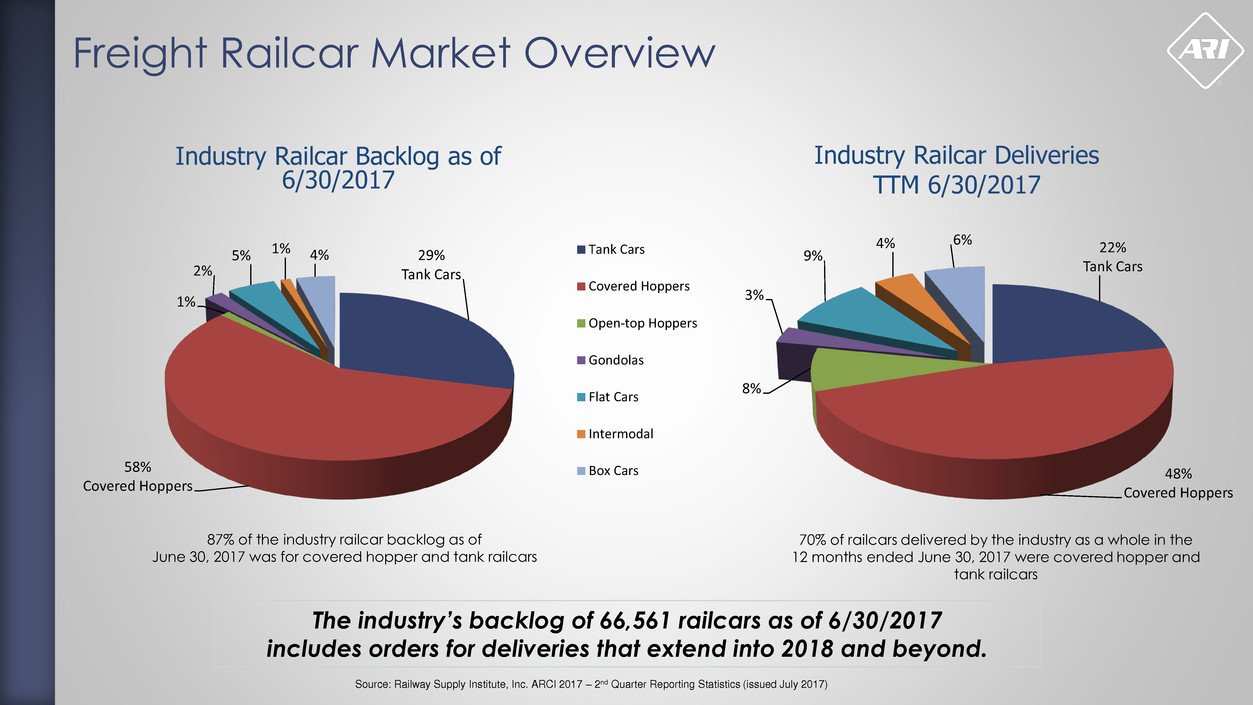
22%
Tank Cars
48%
Covered Hoppers
8%
3%
9%
4% 6%
70% of railcars delivered by the industry as a whole in the
12 months ended June 30, 2017 were covered hopper and
tank railcars
Freight Railcar Market Overview
Source: Railway Supply Institute, Inc. ARCI 2017 – 2nd Quarter Reporting Statistics (issued July 2017)
29%
Tank Cars
58%
Covered Hoppers
1%
2%
5% 1% 4% Tank Cars
Covered Hoppers
Open-top Hoppers
Gondolas
Flat Cars
Intermodal
Box Cars
87% of the industry railcar backlog as of
June 30, 2017 was for covered hopper and tank railcars
Industry Railcar Backlog as of
6/30/2017
The industry’s backlog of 66,561 railcars as of 6/30/2017
includes orders for deliveries that extend into 2018 and beyond.
Industry Railcar Deliveries
TTM 6/30/2017
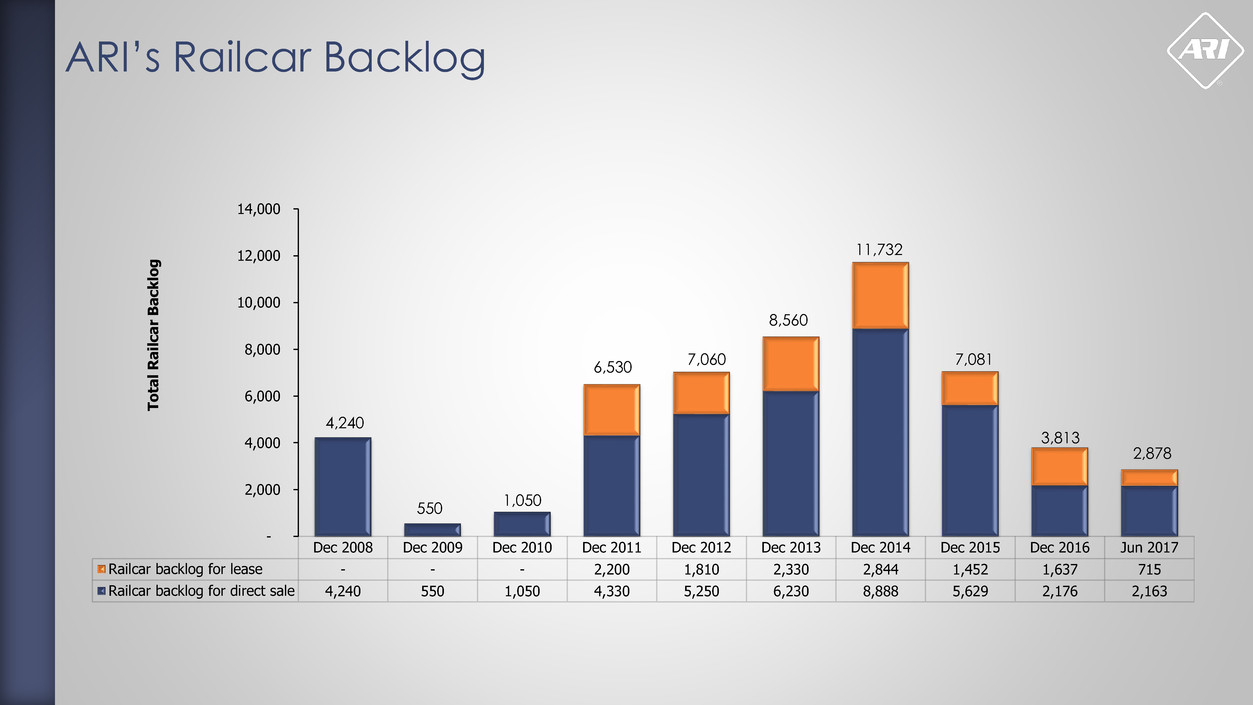
ARI’s Railcar Backlog
Dec 2008 Dec 2009 Dec 2010 Dec 2011 Dec 2012 Dec 2013 Dec 2014 Dec 2015 Dec 2016 Jun 2017
Railcar backlog for lease - - - 2,200 1,810 2,330 2,844 1,452 1,637 715
Railcar backlog for direct sale 4,240 550 1,050 4,330 5,250 6,230 8,888 5,629 2,176 2,163
-
2,000
4,000
6,000
8,000
10,000
12,000
14,000
T
otal
Ra
il
c
ar
Ba
c
k
lo
g
1,050
6,530 7,060
8,560
11,732
7,081
4,240
550
3,813
2,878
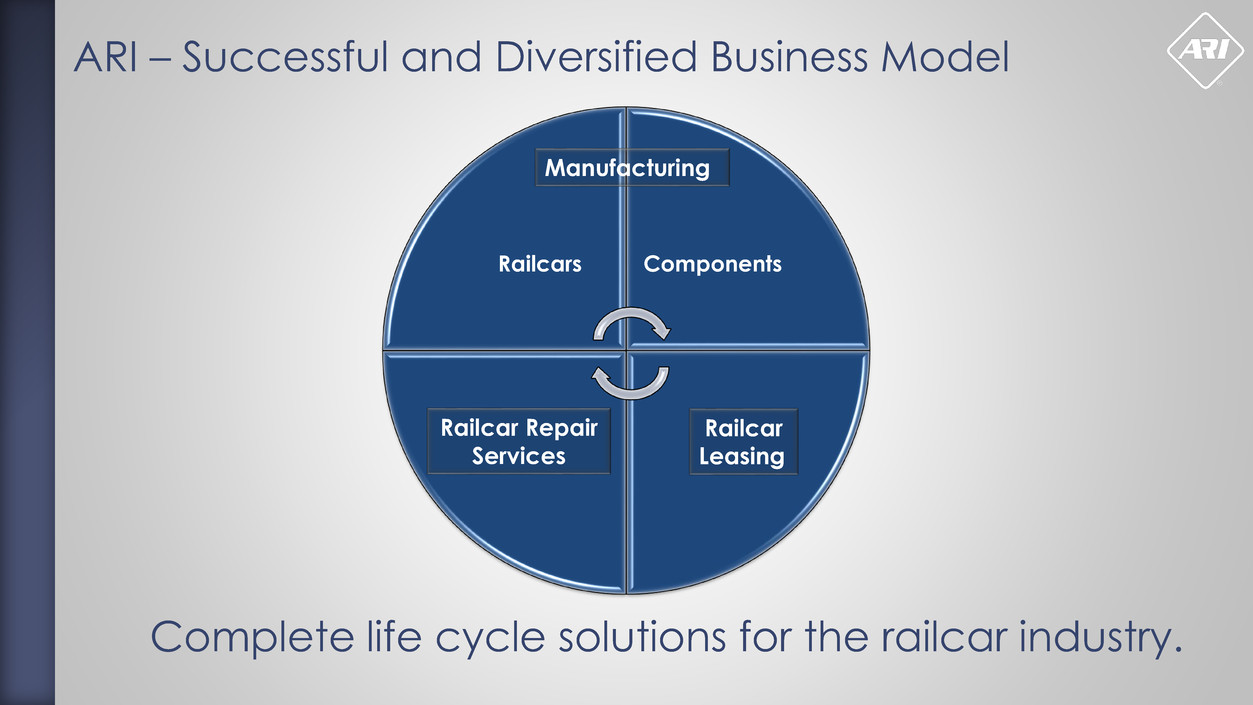
ARI – Successful and Diversified Business Model
Complete life cycle solutions for the railcar industry.
Railcars Components
Manufacturing
Railcar Repair
Services
Railcar
Leasing
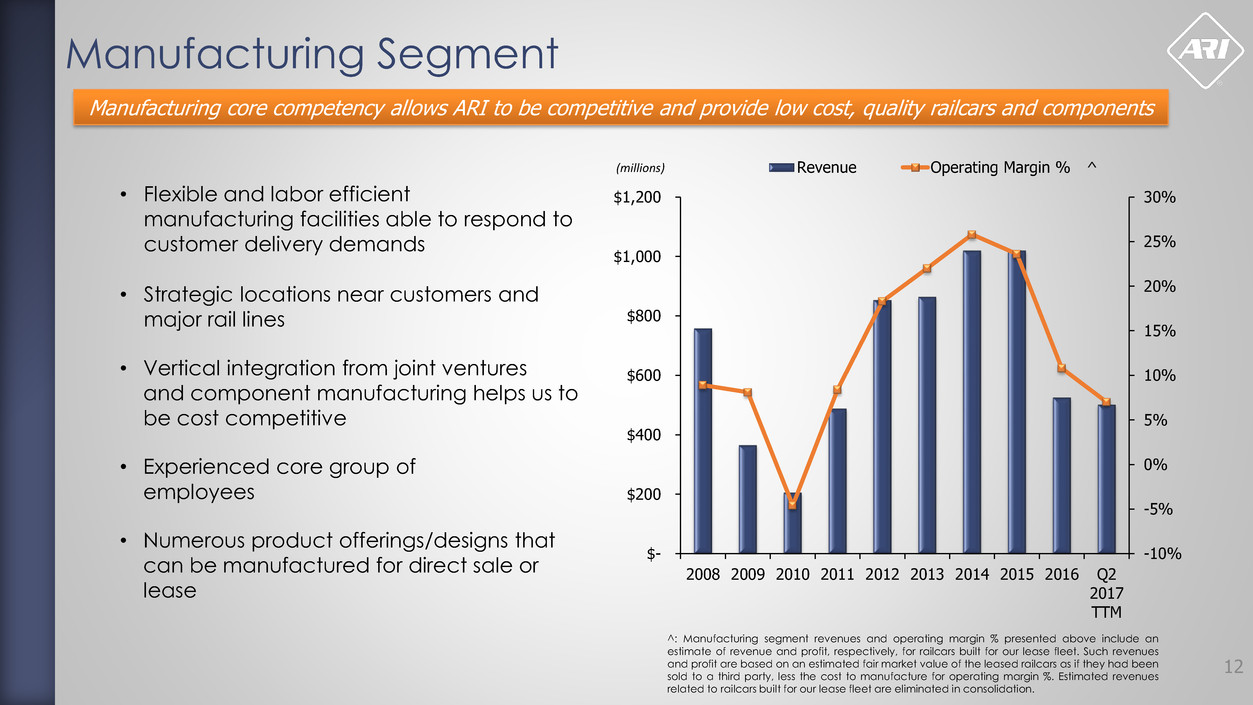
• Flexible and labor efficient
manufacturing facilities able to respond to
customer delivery demands
• Strategic locations near customers and
major rail lines
• Vertical integration from joint ventures
and component manufacturing helps us to
be cost competitive
• Experienced core group of
employees
• Numerous product offerings/designs that
can be manufactured for direct sale or
lease
Manufacturing Segment
12
-10%
-5%
0%
5%
10%
15%
20%
25%
30%
$-
$200
$400
$600
$800
$1,000
$1,200
2008 2009 2010 2011 2012 2013 2014 2015 2016 Q2
2017
TTM
Revenue Operating Margin % ^(millions)
^: Manufacturing segment revenues and operating margin % presented above include an
estimate of revenue and profit, respectively, for railcars built for our lease fleet. Such revenues
and profit are based on an estimated fair market value of the leased railcars as if they had been
sold to a third party, less the cost to manufacture for operating margin %. Estimated revenues
related to railcars built for our lease fleet are eliminated in consolidation.
Manufacturing core competency allows ARI to be competitive and provide low cost, quality railcars and components
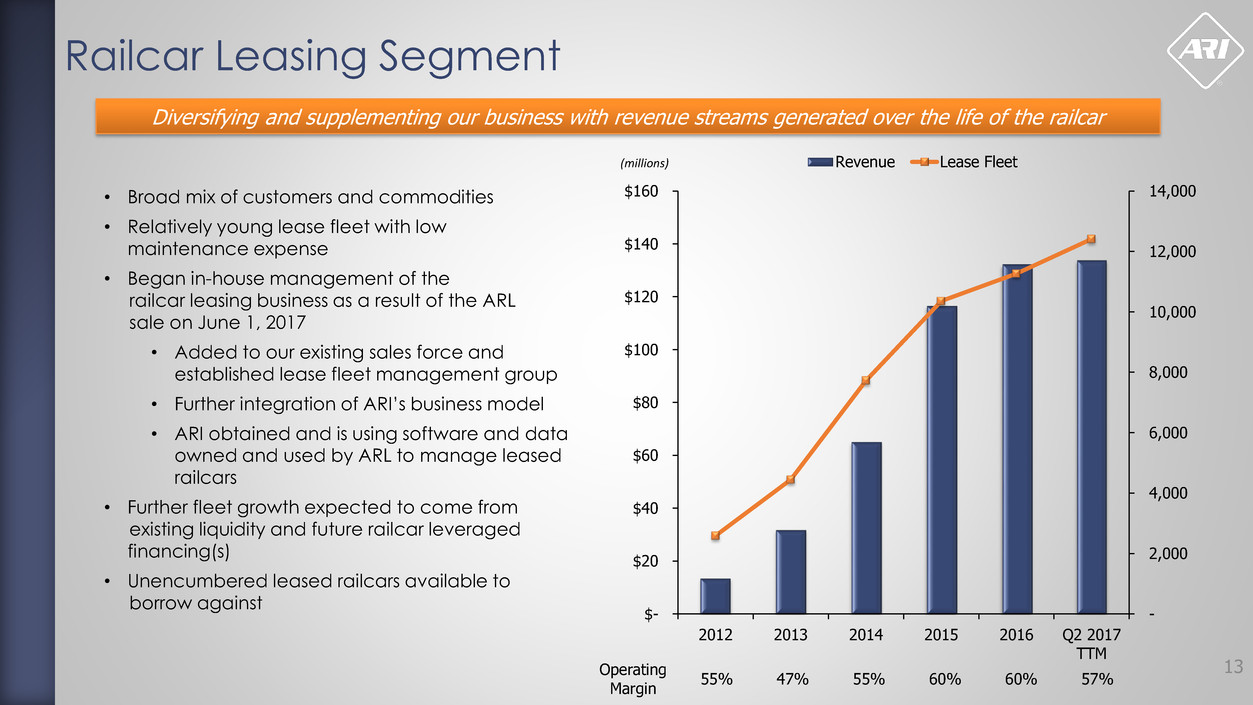
Railcar Leasing Segment
13
Diversifying and supplementing our business with revenue streams generated over the life of the railcar
-
2,000
4,000
6,000
8,000
10,000
12,000
14,000
$-
$20
$40
$60
$80
$100
$120
$140
$160
2012 2013 2014 2015 2016 Q2 2017
TTM
Revenue Lease Fleet(millions)
• Broad mix of customers and commodities
• Relatively young lease fleet with low
maintenance expense
• Began in-house management of the
railcar leasing business as a result of the ARL
sale on June 1, 2017
• Added to our existing sales force and
established lease fleet management group
• Further integration of ARI’s business model
• ARI obtained and is using software and data
owned and used by ARL to manage leased
railcars
• Further fleet growth expected to come from
existing liquidity and future railcar leveraged
financing(s)
• Unencumbered leased railcars available to
borrow against
Operating
Margin
55% 47% 55% 60% 60% 57%
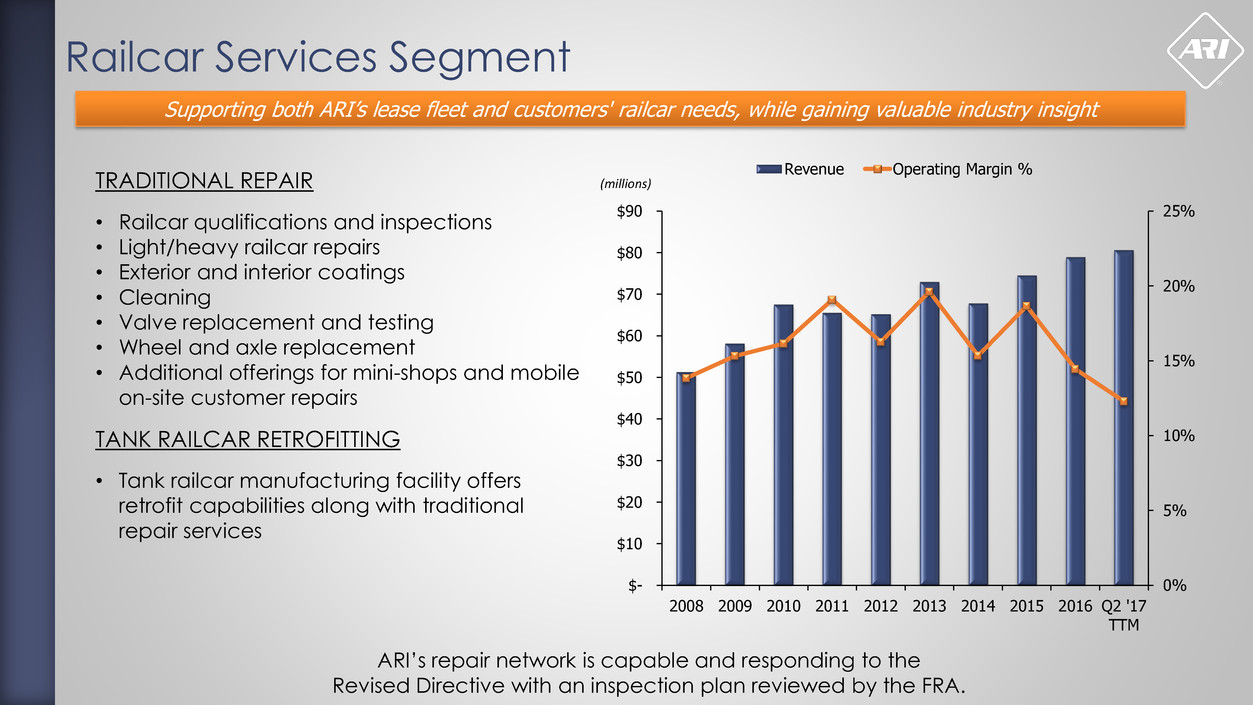
Railcar Services Segment
Supporting both ARI’s lease fleet and customers' railcar needs, while gaining valuable industry insight
TRADITIONAL REPAIR
• Railcar qualifications and inspections
• Light/heavy railcar repairs
• Exterior and interior coatings
• Cleaning
• Valve replacement and testing
• Wheel and axle replacement
• Additional offerings for mini-shops and mobile
on-site customer repairs
TANK RAILCAR RETROFITTING
• Tank railcar manufacturing facility offers
retrofit capabilities along with traditional
repair services
0%
5%
10%
15%
20%
25%
$-
$10
$20
$30
$40
$50
$60
$70
$80
$90
2008 2009 2010 2011 2012 2013 2014 2015 2016 Q2 '17
TTM
Revenue Operating Margin %
(millions)
ARI’s repair network is capable and responding to the
Revised Directive with an inspection plan reviewed by the FRA.
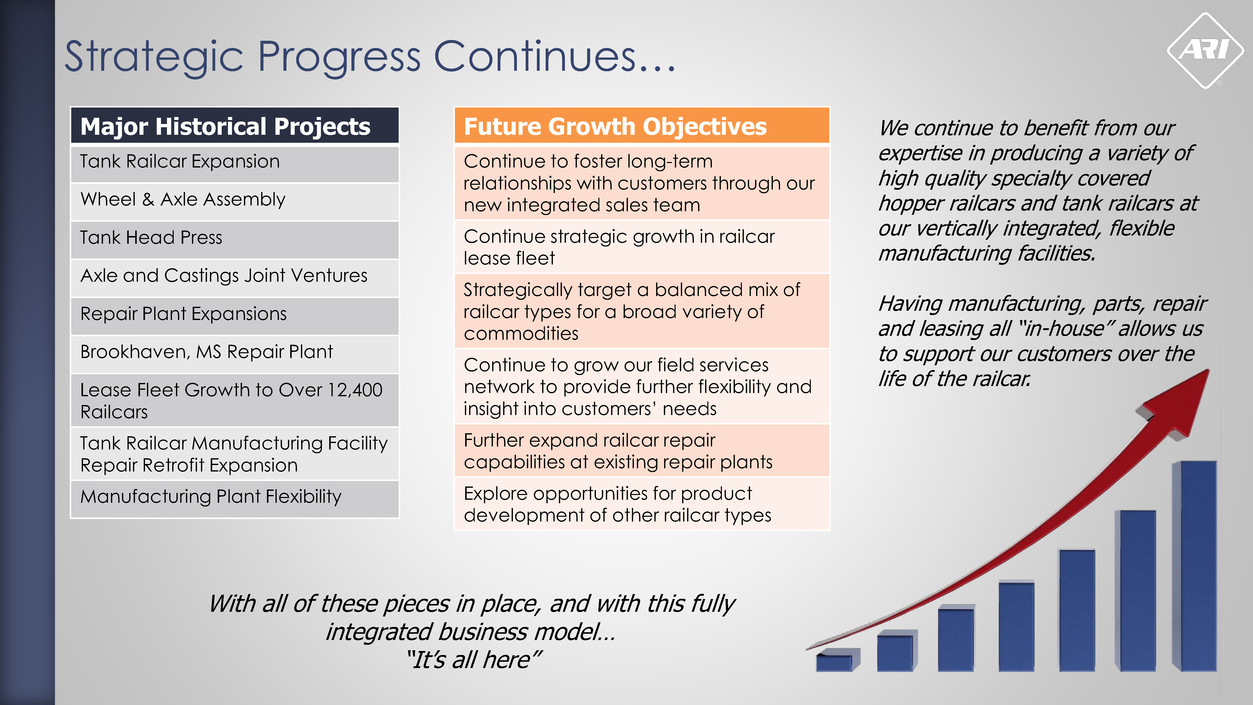
Strategic Progress Continues…
Major Historical Projects
Tank Railcar Expansion
Wheel & Axle Assembly
Tank Head Press
Axle and Castings Joint Ventures
Repair Plant Expansions
Brookhaven, MS Repair Plant
Lease Fleet Growth to Over 12,400
Railcars
Tank Railcar Manufacturing Facility
Repair Retrofit Expansion
Manufacturing Plant Flexibility
Future Growth Objectives
Continue to foster long-term
relationships with customers through our
new integrated sales team
Continue strategic growth in railcar
lease fleet
Strategically target a balanced mix of
railcar types for a broad variety of
commodities
Continue to grow our field services
network to provide further flexibility and
insight into customers’ needs
Further expand railcar repair
capabilities at existing repair plants
Explore opportunities for product
development of other railcar types
We continue to benefit from our
expertise in producing a variety of
high quality specialty covered
hopper railcars and tank railcars at
our vertically integrated, flexible
manufacturing facilities.
Having manufacturing, parts, repair
and leasing all “in-house” allows us
to support our customers over the
life of the railcar.
With all of these pieces in place, and with this fully
integrated business model…
“It’s all here”
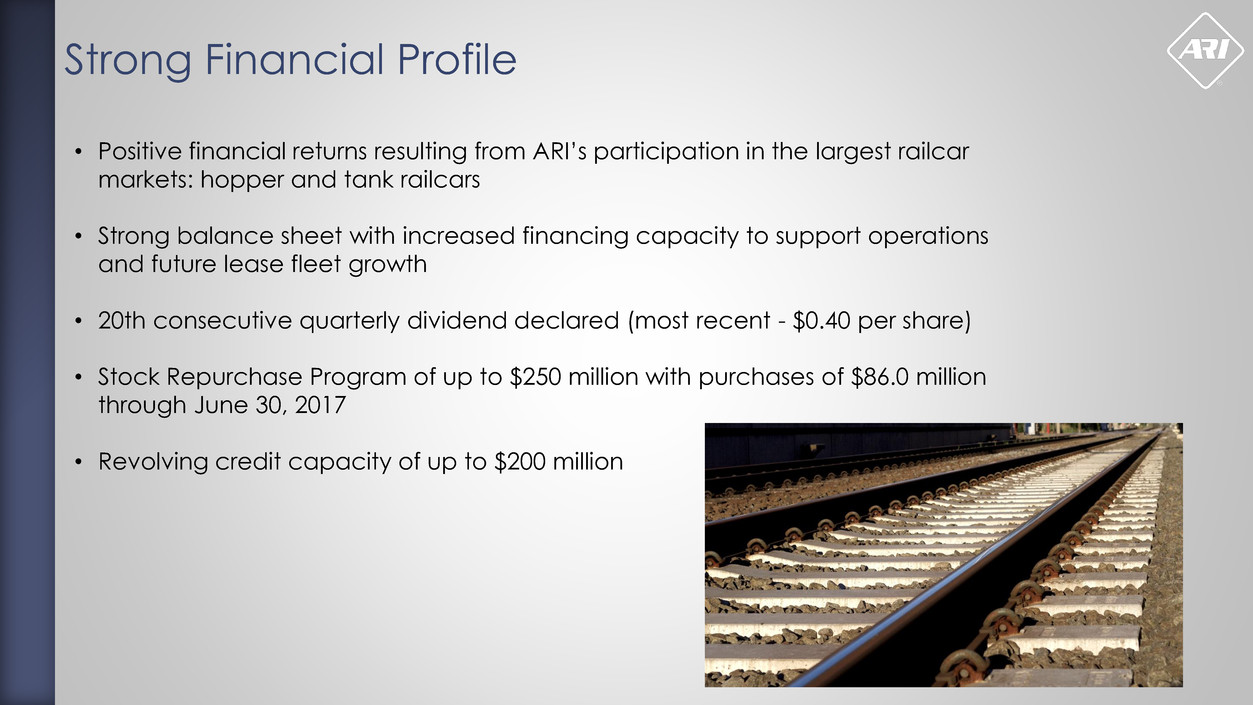
Strong Financial Profile
• Positive financial returns resulting from ARI’s participation in the largest railcar
markets: hopper and tank railcars
• Strong balance sheet with increased financing capacity to support operations
and future lease fleet growth
• 20th consecutive quarterly dividend declared (most recent - $0.40 per share)
• Stock Repurchase Program of up to $250 million with purchases of $86.0 million
through June 30, 2017
• Revolving credit capacity of up to $200 million
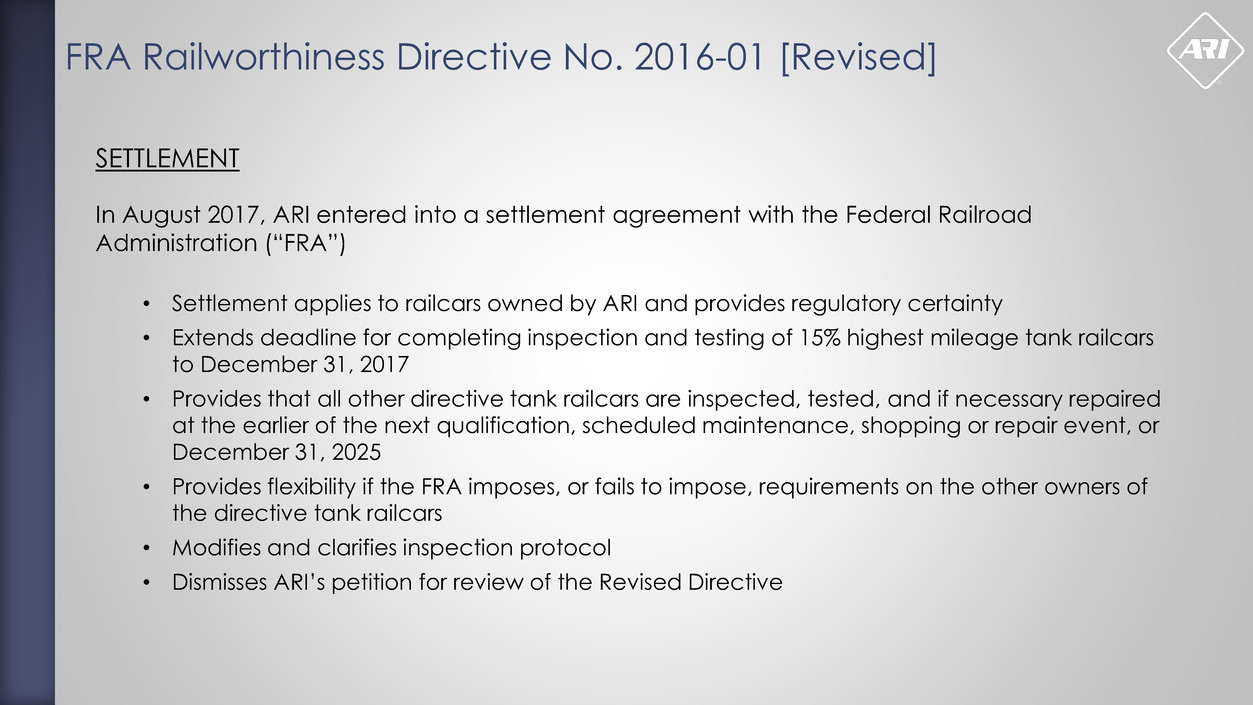
FRA Railworthiness Directive No. 2016-01 [Revised]
SETTLEMENT
In August 2017, ARI entered into a settlement agreement with the Federal Railroad
Administration (“FRA”)
• Settlement applies to railcars owned by ARI and provides regulatory certainty
• Extends deadline for completing inspection and testing of 15% highest mileage tank railcars
to December 31, 2017
• Provides that all other directive tank railcars are inspected, tested, and if necessary repaired
at the earlier of the next qualification, scheduled maintenance, shopping or repair event, or
December 31, 2025
• Provides flexibility if the FRA imposes, or fails to impose, requirements on the other owners of
the directive tank railcars
• Modifies and clarifies inspection protocol
• Dismisses ARI’s petition for review of the Revised Directive
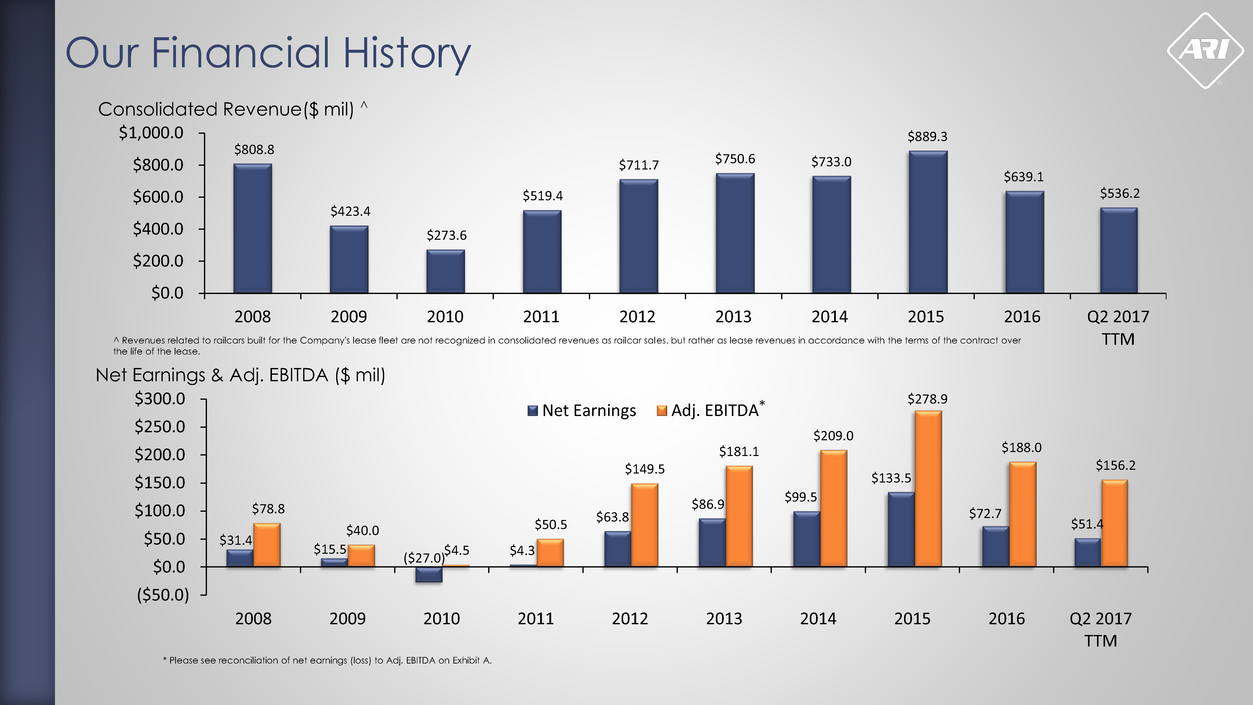
Our Financial History
$808.8
$423.4
$273.6
$519.4
$711.7 $750.6 $733.0
$889.3
$639.1
$536.2
$0.0
$200.0
$400.0
$600.0
$800.0
$1,000.0
2008 2009 2010 2011 2012 2013 2014 2015 2016 Q2 2017
TTM^ Revenues related to railcars built for the Company's lease fleet are not recognized in consolidated revenues as railcar sales, but rather as lease revenues in accordance with the terms of the contract over
the life of the lease.
* Please see reconciliation of net earnings (loss) to Adj. EBITDA on Exhibit A.
$31.4
$15.5
($27.0)
$4.3
$63.8
$86.9 $99.5
$133.5
$72.7
$51.4
$78.8
$40.0
$4.5
$50.5
$149.5
$181.1
$209.0
$278.9
$188.0
$156.2
($50.0)
$0.0
$50.0
$100.0
$150.0
$200.0
$250.0
$300.0
2008 2009 2010 2011 2012 2013 2014 2015 2016 Q2 2017
TTM
Net Earnings Adj. EBITDA*
Consolidated Revenue($ mil) ^
Net Earnings & Adj. EBITDA ($ mil)
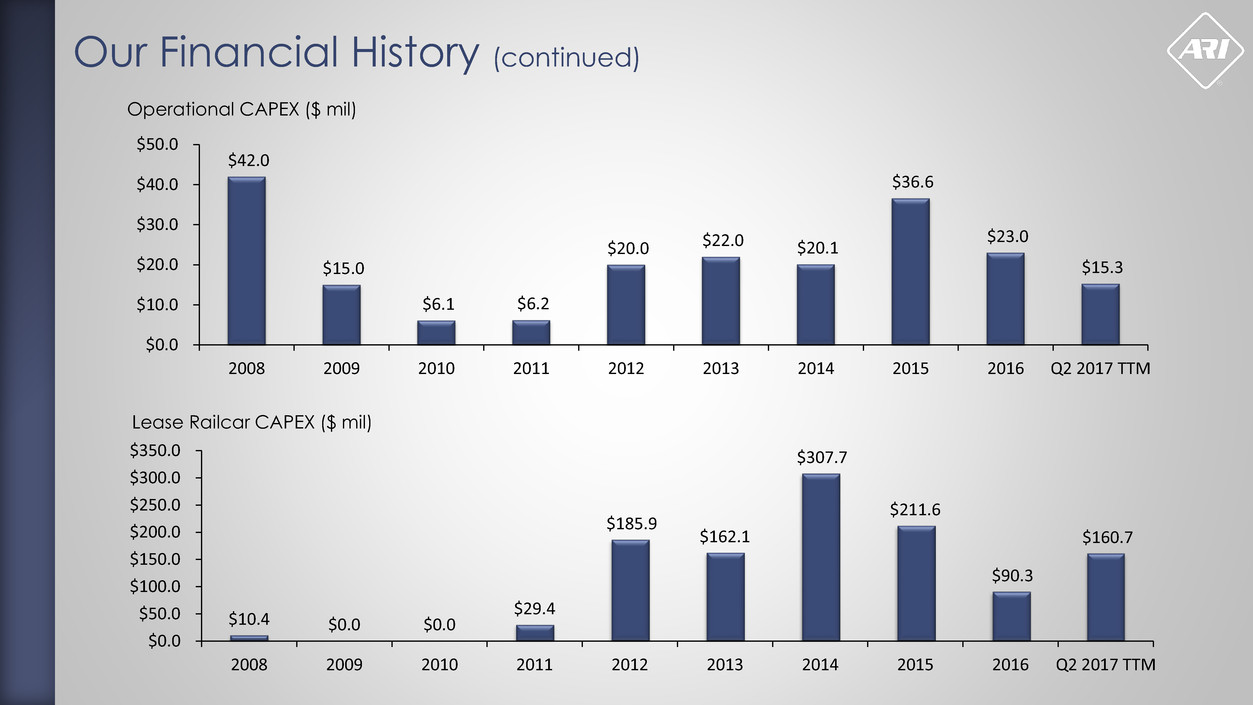
Our Financial History (continued)
$10.4 $0.0 $0.0
$29.4
$185.9
$162.1
$307.7
$211.6
$90.3
$160.7
$0.0
$50.0
$100.0
$150.0
$200.0
$250.0
$300.0
$350.0
2008 2009 2010 2011 2012 2013 2014 2015 2016 Q2 2017 TTM
Lease Railcar CAPEX ($ mil)
Operational CAPEX ($ mil)
$42.0
$15.0
$6.1 $6.2
$20.0 $22.0 $20.1
$36.6
$23.0
$15.3
$0.0
$10.0
$20.0
$30.0
$40.0
$50.0
2008 2009 2010 2011 2012 2013 2014 2015 2016 Q2 2017 TTM
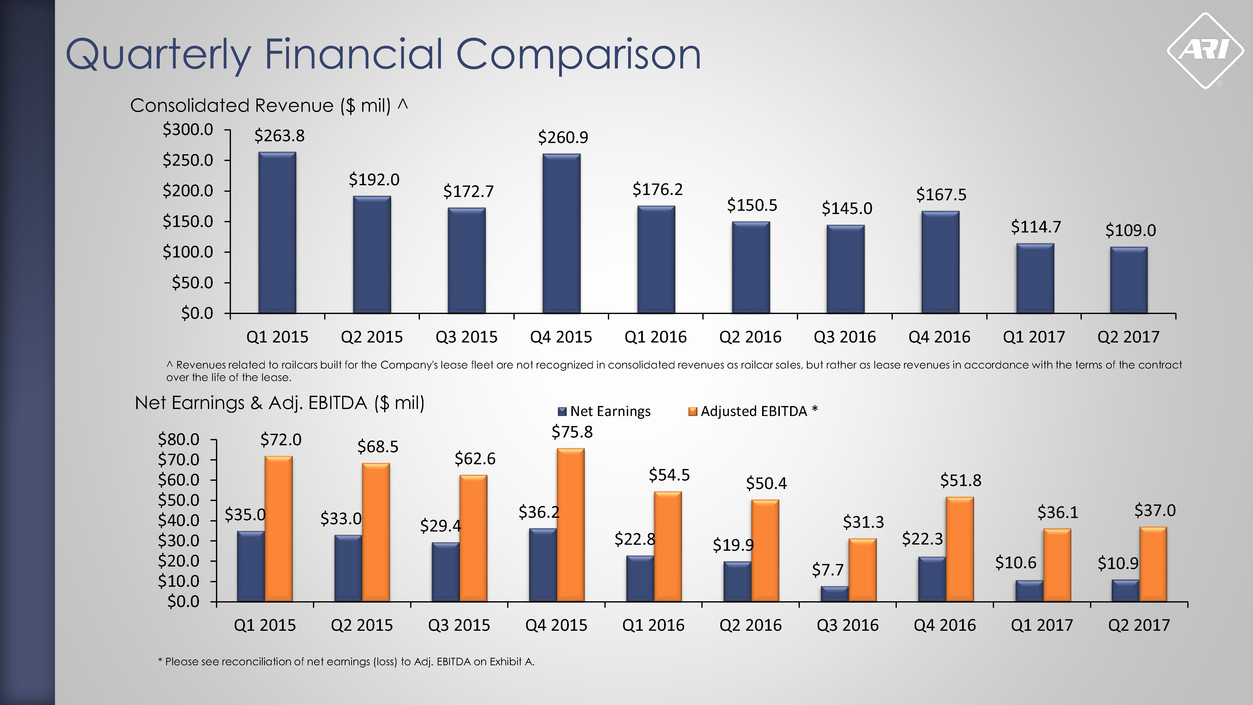
Quarterly Financial Comparison
$263.8
$192.0
$172.7
$260.9
$176.2
$150.5 $145.0
$167.5
$114.7 $109.0
$0.0
$50.0
$100.0
$150.0
$200.0
$250.0
$300.0
Q1 2015 Q2 2015 Q3 2015 Q4 2015 Q1 2016 Q2 2016 Q3 2016 Q4 2016 Q1 2017 Q2 2017
^ Revenues related to railcars built for the Company's lease fleet are not recognized in consolidated revenues as railcar sales, but rather as lease revenues in accordance with the terms of the contract
over the life of the lease.
Consolidated Revenue ($ mil) ^
$35.0 $33.0 $29.4
$36.2
$22.8 $19.9
$7.7
$22.3
$10.6 $10.9
$72.0 $68.5
$62.6
$75.8
$54.5 $50.4
$31.3
$51.8
$36.1 $37.0
$0.0
$10.0
$20.0
$30.0
$40.0
$50.0
$60.0
$70.0
$80.0
Q1 2015 Q2 2015 Q3 2015 Q4 2015 Q1 2016 Q2 2016 Q3 2016 Q4 2016 Q1 2017 Q2 2017
Net Earnings Adjusted EBITDA *
* Please see reconciliation of net earnings (loss) to Adj. EBITDA on Exhibit A.
Net Earnings & Adj. EBITDA ($ mil)

Quarterly Financial Comparison (continued)
$5.0
$10.4
$11.1
$10.1
$4.4
$6.7
$4.8
$7.1
$1.6 $1.8
$0.0
$2.0
$4.0
$6.0
$8.0
$10.0
$12.0
Q1 2015 Q2 2015 Q3 2015 Q4 2015 Q1 2016 Q2 2016 Q3 2016 Q4 2016 Q1 2017 Q2 2017
$48.1
$84.5
$77.7
$1.3
$20.6
$12.8
$36.0
$20.9
$55.9
$47.9
$0.0
$20.0
$40.0
$60.0
$80.0
$100.0
Q1 2015 Q2 2015 Q3 2015 Q4 2015 Q1 2016 Q2 2016 Q3 2016 Q4 2016 Q1 2017 Q2 2017
# Includes effect of leased railcars in process.
Operational CAPEX ($ mil)
Lease Railcar CAPEX ($ mil) #
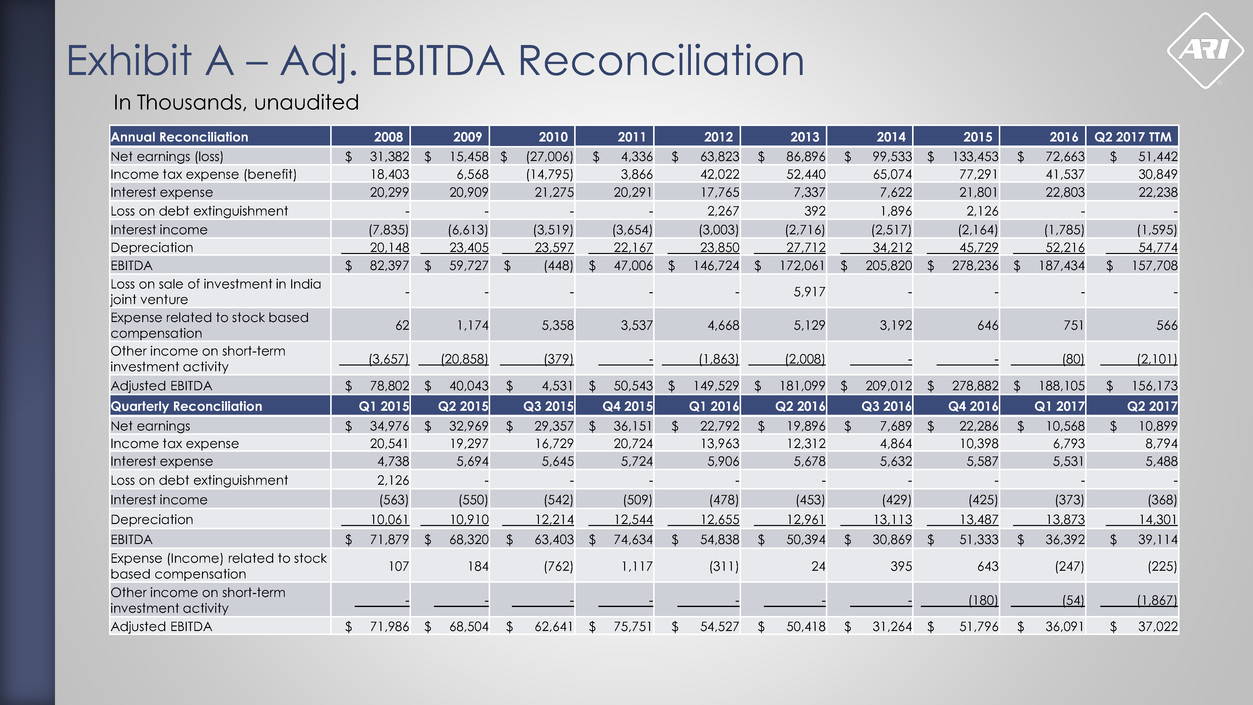
Exhibit A – Adj. EBITDA Reconciliation
In Thousands, unaudited
Annual Reconciliation 2008 2009 2010 2011 2012 2013 2014 2015 2016 Q2 2017 TTM
Net earnings (loss) $ 31,382 $ 15,458 $ (27,006) $ 4,336 $ 63,823 $ 86,896 $ 99,533 $ 133,453 $ 72,663 $ 51,442
Income tax expense (benefit) 18,403 6,568 (14,795) 3,866 42,022 52,440 65,074 77,291 41,537 30,849
Interest expense 20,299 20,909 21,275 20,291 17,765 7,337 7,622 21,801 22,803 22,238
Loss on debt extinguishment - - - - 2,267 392 1,896 2,126 - -
Interest income (7,835) (6,613) (3,519) (3,654) (3,003) (2,716) (2,517) (2,164) (1,785) (1,595)
Depreciation 20,148 23,405 23,597 22,167 23,850 27,712 34,212 45,729 52,216 54,774
EBITDA $ 82,397 $ 59,727 $ (448) $ 47,006 $ 146,724 $ 172,061 $ 205,820 $ 278,236 $ 187,434 $ 157,708
Loss on sale of investment in India
joint venture
- - - - - 5,917 - - - -
Expense related to stock based
compensation
62 1,174 5,358 3,537 4,668 5,129 3,192 646 751 566
Other income on short-term
investment activity
(3,657) (20,858) (379) - (1,863) (2,008) - - (80) (2,101)
Adjusted EBITDA $ 78,802 $ 40,043 $ 4,531 $ 50,543 $ 149,529 $ 181,099 $ 209,012 $ 278,882 $ 188,105 $ 156,173
Quarterly Reconciliation Q1 2015 Q2 2015 Q3 2015 Q4 2015 Q1 2016 Q2 2016 Q3 2016 Q4 2016 Q1 2017 Q2 2017
Net earnings $ 34,976 $ 32,969 $ 29,357 $ 36,151 $ 22,792 $ 19,896 $ 7,689 $ 22,286 $ 10,568 $ 10,899
Income tax expense 20,541 19,297 16,729 20,724 13,963 12,312 4,864 10,398 6,793 8,794
Interest expense 4,738 5,694 5,645 5,724 5,906 5,678 5,632 5,587 5,531 5,488
Loss on debt extinguishment 2,126 - - - - - - - - -
Interest income (563) (550) (542) (509) (478) (453) (429) (425) (373) (368)
Depreciation 10,061 10,910 12,214 12,544 12,655 12,961 13,113 13,487 13,873 14,301
EBITDA $ 71,879 $ 68,320 $ 63,403 $ 74,634 $ 54,838 $ 50,394 $ 30,869 $ 51,333 $ 36,392 $ 39,114
Expense (Income) related to stock
based compensation
107 184 (762) 1,117 (311) 24 395 643 (247) (225)
Other income on short-term
investment activity
- - - - - - - (180) (54) (1,867)
Adjusted EBITDA $ 71,986 $ 68,504 $ 62,641 $ 75,751 $ 54,527 $ 50,418 $ 31,264 $ 51,796 $ 36,091 $ 37,022
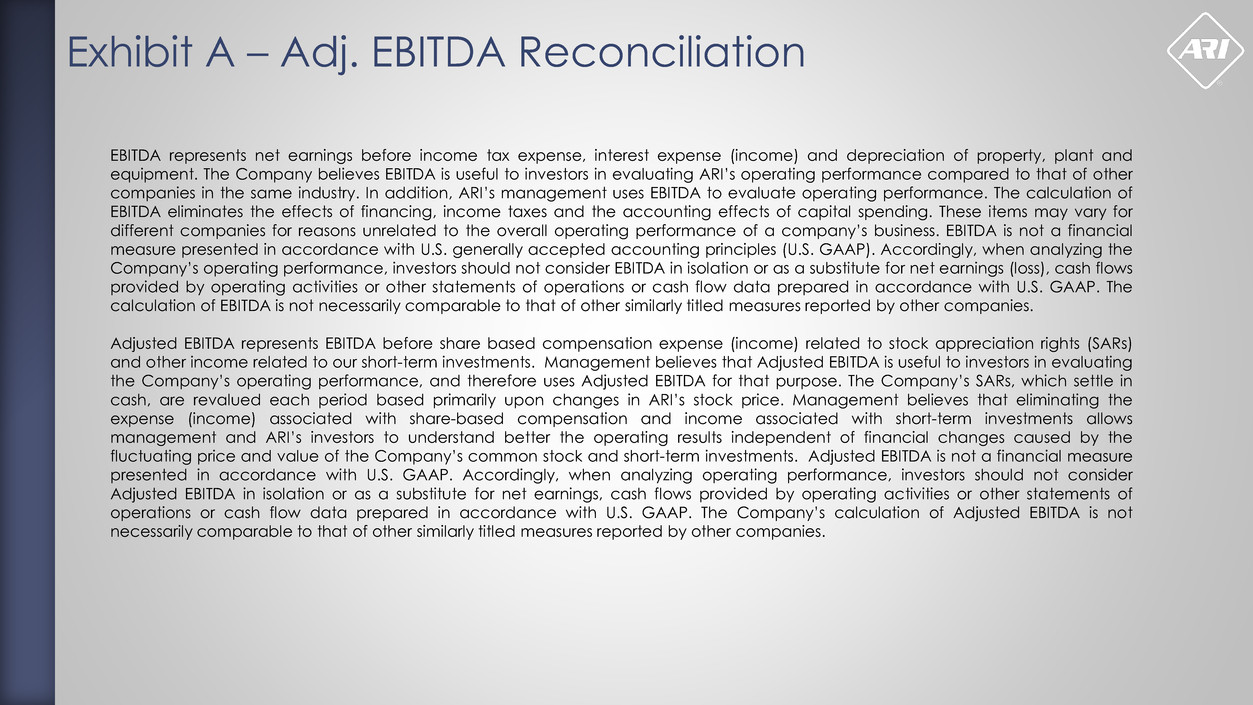
Exhibit A – Adj. EBITDA Reconciliation
EBITDA represents net earnings before income tax expense, interest expense (income) and depreciation of property, plant and
equipment. The Company believes EBITDA is useful to investors in evaluating ARI’s operating performance compared to that of other
companies in the same industry. In addition, ARI’s management uses EBITDA to evaluate operating performance. The calculation of
EBITDA eliminates the effects of financing, income taxes and the accounting effects of capital spending. These items may vary for
different companies for reasons unrelated to the overall operating performance of a company’s business. EBITDA is not a financial
measure presented in accordance with U.S. generally accepted accounting principles (U.S. GAAP). Accordingly, when analyzing the
Company’s operating performance, investors should not consider EBITDA in isolation or as a substitute for net earnings (loss), cash flows
provided by operating activities or other statements of operations or cash flow data prepared in accordance with U.S. GAAP. The
calculation of EBITDA is not necessarily comparable to that of other similarly titled measures reported by other companies.
Adjusted EBITDA represents EBITDA before share based compensation expense (income) related to stock appreciation rights (SARs)
and other income related to our short-term investments. Management believes that Adjusted EBITDA is useful to investors in evaluating
the Company’s operating performance, and therefore uses Adjusted EBITDA for that purpose. The Company’s SARs, which settle in
cash, are revalued each period based primarily upon changes in ARI’s stock price. Management believes that eliminating the
expense (income) associated with share-based compensation and income associated with short-term investments allows
management and ARI’s investors to understand better the operating results independent of financial changes caused by the
fluctuating price and value of the Company’s common stock and short-term investments. Adjusted EBITDA is not a financial measure
presented in accordance with U.S. GAAP. Accordingly, when analyzing operating performance, investors should not consider
Adjusted EBITDA in isolation or as a substitute for net earnings, cash flows provided by operating activities or other statements of
operations or cash flow data prepared in accordance with U.S. GAAP. The Company’s calculation of Adjusted EBITDA is not
necessarily comparable to that of other similarly titled measures reported by other companies.
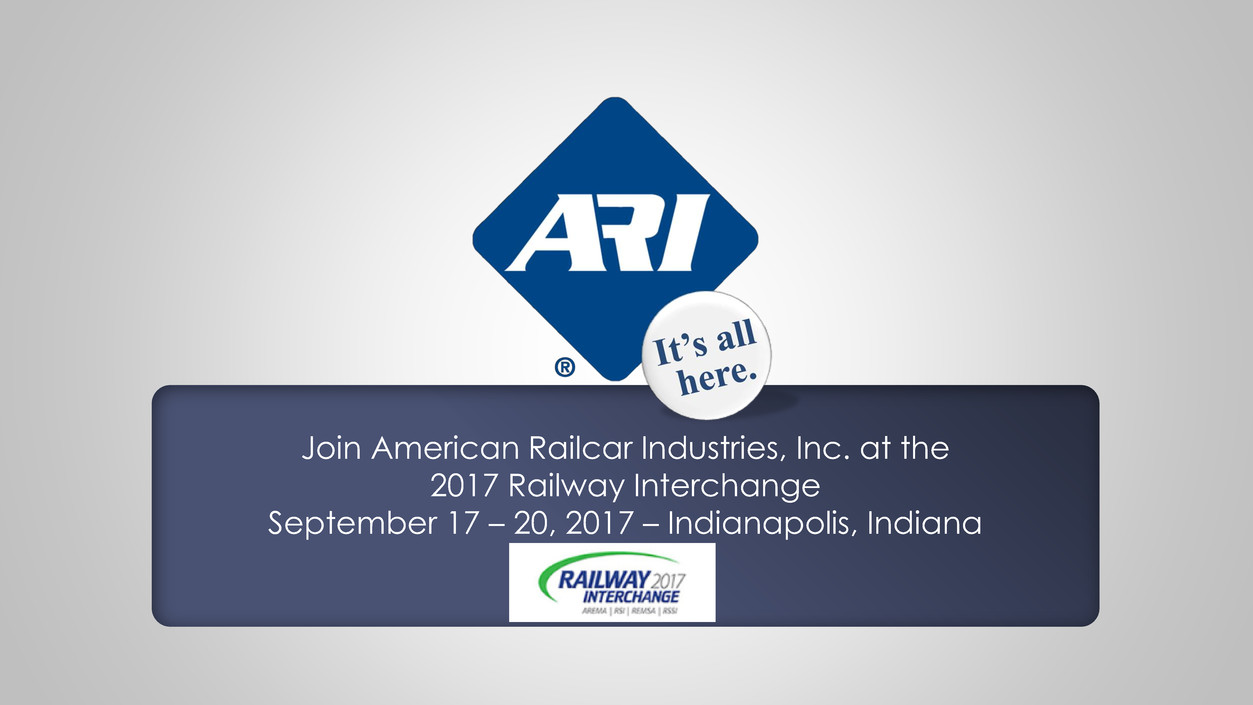
Join American Railcar Industries, Inc. at the
2017 Railway Interchange
September 17 – 20, 2017 – Indianapolis, Indiana
